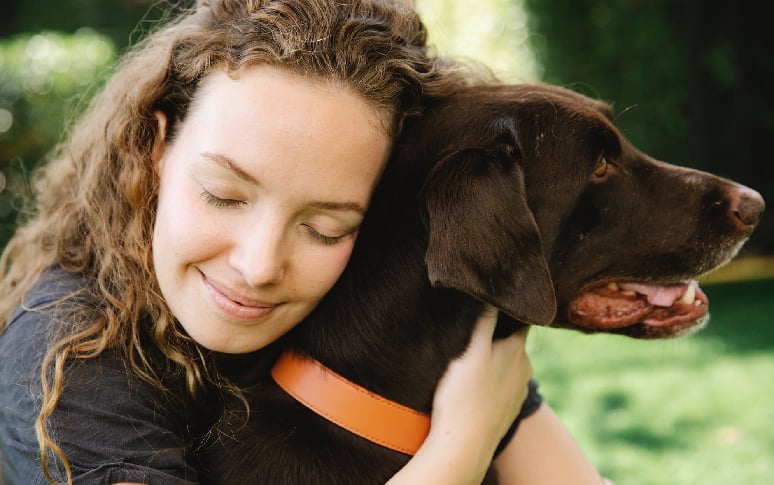1. Hugging
For many of us, hugging is a natural way to express affection. We hug our friends, family, and of course, our adorable dogs. However, what we often fail to realize is that most dogs aren't fans of this gesture. Dogs perceive hugging as a form of dominance or restriction of their movement, which can cause them stress or anxiety. Instead of hugging, try showing your affection through gentle petting or verbal praise.
This doesn't mean that all dogs despise hugs. Some dogs, especially those who have been accustomed to it from a young age, might enjoy hugging. Always observe your dog's body language to ensure they are comfortable with the interaction.

2. Yelling Or Loud Noises
Dogs have a heightened sense of hearing compared to humans. They can hear higher-pitched sounds and can detect sounds far away, making them incredibly sensitive to loud noises. Yelling or sudden loud sounds may scare them and create an environment of stress and fear.
Even if your dog has done something wrong, yelling is not an effective way to correct their behavior. Instead of yelling when your dog misbehaves, try using a firm but calm voice to correct them. Positive reinforcement, such as treats or praise for good behavior, is often more effective than punishment. Remember, patience and consistent training do help in teaching your dog desirable behavior.

3. Forcing Interaction With Other Dogs Or People
Just like humans, dogs have their own personalities and comfort levels when it comes to socializing. Forcing your dog to interact with other dogs or people, especially if they seem uncomfortable or scared, can lead to anxiety and fear. Always allow your dog to approach others at their own pace and respect their boundaries if they choose to keep their distance.

4. Lack Of Routine
Dogs need routine and predictability. Regular feeding times, walks, and play sessions help them feel secure and comfortable. Disrupting this routine or inconsistency can cause stress and behavioral problems. Try to maintain a consistent schedule for your dog's daily activities to keep them happy and well-adjusted.

5. Teasing
While it might seem like harmless fun to tease your dog by waving a toy just out of their reach or 5l, dogs can find this behavior frustrating. Teasing can lead to anxiety, frustration, and even aggressive behavior. Always interact with your dog in a respectful and considerate manner.

6. Ignoring Their Body Language
Dogs communicate their feelings and needs primarily through body language. Ignoring signs of fear, discomfort, or stress can lead to anxiety and behavioral problems. It's important to familiarize yourself with common dog body language signs, such as tail positioning, ear movement, and body posture, to understand your dog's feelings and needs better.

7. Inconsistent Rules
Dogs are creatures of habit and thrive on consistency. Changing the rules or expectations may confuse them and lead to behavioral problems. For example, if you allow your dog on the couch one day but scold them for it the next, they won't understand what they're allowed to do. Consistency in training and rules helps your dog understand what is expected of them.

8. Limited Exercise
Dogs need regular physical exercise and mental stimulation to stay healthy and happy. Lack of exercise can lead to obesity, boredom, and destructive behavior. The amount of exercise needed can vary based on their breed, age, and health. Regular walks, play sessions, and mental stimulation such as puzzle toys or training can help keep your dog active and engaged.

9. Prolonged Eye Contact
While humans often view eye contact as a sign of attention or respect, many dogs can find prolonged eye contact threatening. In dog language, staring directly into another dog's eyes can be seen as a challenge or a sign of dominance. If you notice your dog becoming tense or uncomfortable when you make eye contact, it's best to divert your gaze.

10. Leaving Them Alone For Long Periods
Dogs are social creatures and can experience separation anxiety when left alone for long periods. This can lead to destructive behavior, excessive barking, and other signs of distress. If you're away from home often, consider hiring a pet sitter or dog walker, or explore doggy daycare options.
Understanding and respecting our dogs' needs and boundaries can significantly enhance the bond we share with them. By being aware of these common behaviors that dogs dislike, we can create a more comfortable, stress-free environment for our canine companions. Remember, every dog is unique, and what works for one may not work for another. Observing and understanding your dog's individual personality and preferences is key to a happy and healthy relationship.

Was this page helpful? Give us a thumbs up!












